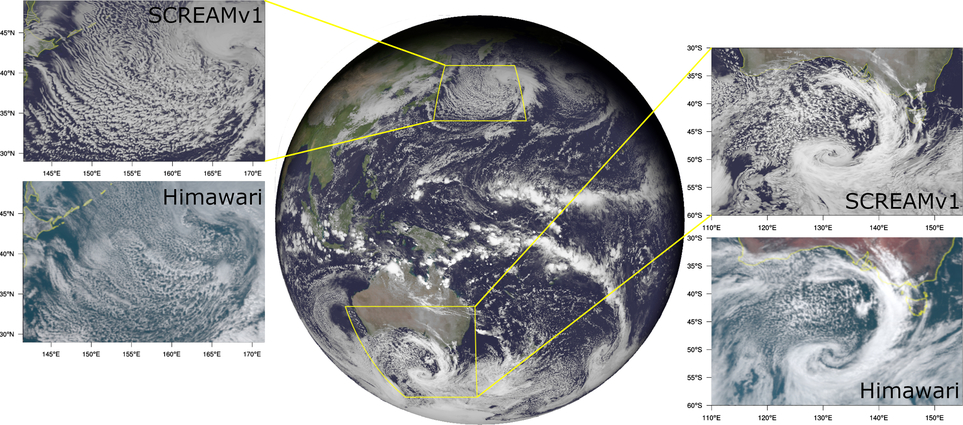LLNL scientists among finalists for new Gordon Bell climate modeling award
 (Download Image)
(Download Image)
The Gordon Bell Prize for Climate Modeling submission details the Simple Cloud Resolving E3SM Atmosphere Model (SCREAM) team’s record-setting demonstration of SCREAM on Oak Ridge National Laboratory’s 1.2 exascale supercomputer Frontier.
A team from Lawrence Livermore National Laboratory (LLNL) and seven other Department of Energy (DOE) national laboratories is a finalist for the new Association for Computing Machinery (ACM) Gordon Bell Prize for Climate Modeling for running an unprecedented high-resolution global atmosphere model on the world’s first exascale supercomputer.
The Gordon Bell submission, led by Energy Exascale Earth System Model (E3SM) chief computational scientist Mark Taylor, details the team’s record-setting demonstration of the Simple Cloud Resolving E3SM Atmosphere Model (SCREAM) on Oak Ridge National Laboratory’s 1.2 exaFLOP (1.2 quintillion computing operations per second) Frontier machine.
Incorporating state-of-the-art parameterizations for fluid dynamics, microphysics, moist turbulence and radiation, SCREAM is a full-featured atmospheric general circulation model developed for very fine-resolution simulations on exascale machines. The effort is led by LLNL staff scientist Peter Caldwell, who also heads the Lab’s Climate Modeling group.
A cornerstone of SCREAM development is computationally-efficient performance-portable design, a feature allowing SCREAM to become — as far as the team is aware — the first nonhydrostatic global atmospheric model with resolution finer than 5 kilometers to run on an exascale supercomputer, to run at scale on both NVIDIA and AMD Graphics Processing Unit (GPU) systems, and to exceed one simulated-year-per-day of throughput. SCREAM earned its Gordon Bell finalist position from a record-setting run performed earlier this year, and a revised submission boasts results 54% faster than the original entry, obtaining a performance of 1.26 simulated years per day on 8,192 Frontier nodes.
“The Gordon Bell Prize is the highest honor in high performance computing,” said LLNL’s Caldwell. “E3SM is very proud and excited to be finalists for the inaugural year of the Gordon Bell Climate Award. We worked extremely hard for five years to develop a model which makes efficient use of exascale computers, providing more trustworthy and higher-fidelity predictions of future climate than were previously possible. The aim of this new prize matches our goals exactly, so we were hopeful about our chances.”
What separates SCREAM from other climate models is that it was written in C++ and uses the Kokkos library, enabling it to perform efficiently across the spectrum of computer architectures, Caldwell said. The design choice allowed the SCREAM team to run on Frontier faster than any other climate model, he said, adding that “most climate and weather models are struggling to take advantage of the GPUs that power most of today’s top powerful supercomputers. SCREAM is of huge interest to other modeling centers as a successful example of how to make this transition.”
The SCREAM effort grew out of the E3SM team, a multi-lab DOE partnership led by LLNL scientist Dave Bader, that is tasked with developing a state-of-the-art climate modeling, simulation and prediction project for exascale supercomputers. Sponsored by the U.S. Department of Energy’s (DOE’s) Office of Biological and Environmental Research, the E3SM team includes researchers and computational scientists at LLNL and the Sandia, Argonne, Brookhaven, Los Alamos, Lawrence Berkeley, Oak Ridge and Pacific Northwest national laboratories. Other LLNL staff named in the Gordon Bell entry include scientists Aaron Donahue, Chris Terai and Renata McCoy.
Team members said the achievement represents a breakthrough in climate modeling and a significant milestone for the E3SM project, which aims to bring DOE’s cutting-edge computer science to bear on the climate simulation challenge by simulating the climate system at very high resolution. Such high resolution permits explicit resolution of large convective circulations and other important atmospheric phenomena, thereby avoiding critical sources of uncertainty in traditional climate models, according to researchers. Fine resolution also is necessary to capture critical aspects of the climate that might impact conditions in the United States in the coming decades, such as extreme temperatures, storms and sea level rise.
The Gordon Bell Prize for Climate Modeling “aims to recognize innovative parallel computing contributions toward solving the global climate crisis,” according to ACM. It will be awarded for the first time this year at the International Conference for High Performance Computing, Networking, Storage, and Analysis (SC23) in Denver, and accompanied by a $10,000 award provided by Gordon Bell. Winners will be selected based on their potential to impact climate modeling and related fields.
Contact
 Jeremy Thomas
Jeremy Thomas
[email protected]
(925) 422-5539
Related Links
See more about E3SMTags
ASCEarth and Atmospheric Science
Atmospheric, Earth, and Energy
HPC, Simulation, and Data Science
Computing
Physical and Life Sciences
Science
Featured Articles







